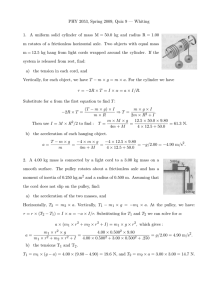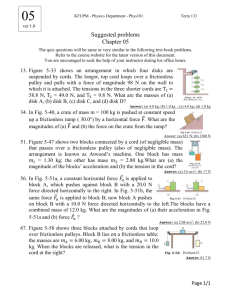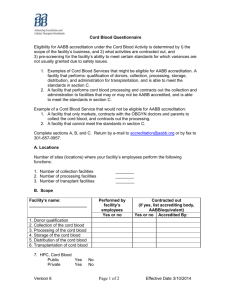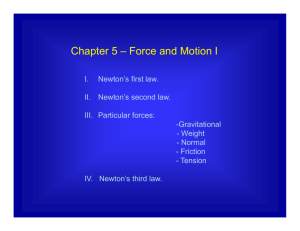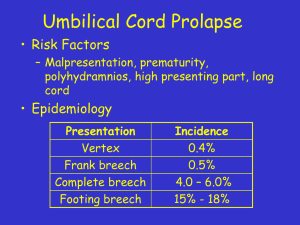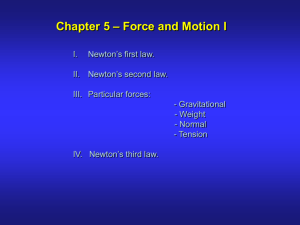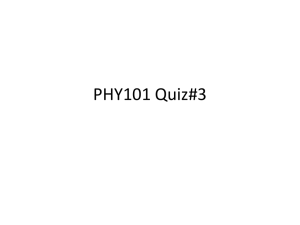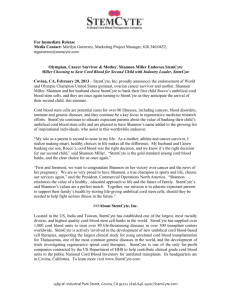solution for sample problems
advertisement
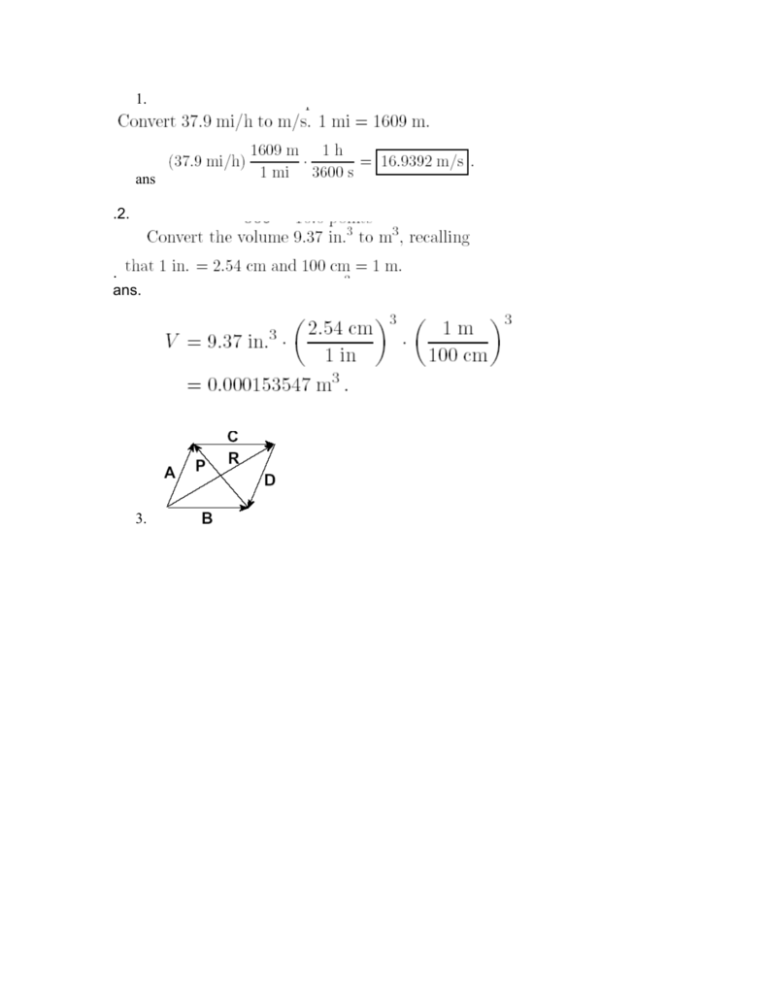
1. ans .2. . ans. 3. 4. 5. 6. 7. v sin 2 R= o ; g 2 8. 9. Find the tension in the cord T=ma=17.19 N 10. A cord holds a 15 kg block stationary on a frictionless plane inclined at angle 27 degree. We now cut the cord. Does the block accelerate as it slides down the inclined plane? What is its acceleration? (x-up the incline) a= -(9.8 m/s2 )(sin270) = -4.4 m/s2 11. A dart is thrown horizontally toward X at 20m/s as shown. It hits Y 0.1 s later. The distance XY is: A. 2m B. 1m C. 0.5m D. 0.1m E. 0.05m 12. A 1500 kg car moving on a flat, horizontal road negotiates a curve. If the radius of the curve is 35 m and coefficient of static friction between the tires and dry pavement is 0.523, find the maximum speed the car can have and still make the turn successfully. n+ fs + Fg=mac on the verge of skidding outward fs.max= s.n x direction radial fs.max= s.n =mv2max /r y: s.n =s.mg =mv2max /r n-mg=0 n=mg v2max=s.gr vmax =((0.523)(9.8 m/s2)(35.o m)) 1/2 =13.4 m/s 13. A sphere of mass m=500kg is attached to the end of a cord of length R=10 m and set into motion in a vertical circle about a fixed point O with vtop=20m/s. Find the tension in the cord at any instant when the speed of the sphere is vbot and the cord makes angle =0 with the vertical. Here you have nonuniform motion, tangential component of acceleration arises from mg. T +Fg= ma Tension on the bottom max T=n ( notation) 2 v bot T mg 1 Rg 500 kg 20.0 m s2 Mv 2 2 n Mg 500 kg 9.80 m s R 10.0 m 4 n 4 900 N 20 000 N 2.49 10 N 14. A=2I+3J, B= -I+2J find A*B A*B=(2I+3J)*( -I+2J)= -2i*i+2i*2j- 3j*i+3j*2j= -2*1+4*0-3*0+6*1 = -2+6=4 number( scalar not vector) 15. Find the angle between A and B A=( Ax2 + Ay2) 1/2=( 22 + 32) 1/2=( 13) ½ B=( Bx2 + By2) 1/2=( ( -1)2 + 22) 1/2=( 5) ½ ABcosA*B cos A*B)/ A*B=4/((13) 1/2 (5) 1/2) =4/(65 ) 1/2 cos -1 4/(65 ) ½=60.3 o 16. 17. When a mass, m=2 kg, is suspended from a spring and the system is allowed to reach equilibrium, as shown in Figure , Newton's Second Law tells us that the magnitude of the spring force equals the weight of the body, . Therefore, if we know the mass of a body at equilibrium, we can determine the spring force acting on the body. If ( where is the body's displacement(2 cm). = 1.96N). We can then determine the spring constant for this spring: 18. A ball of mass m is dropped from a height h above the ground a)Find the speed of the ball when it is at height y above the ground. Kf- Ki= mvf2/2- 0 =Wg= mg(h-y) vf2=2g(h-y) vf= (2g(h-y)) ½ 19. A 103-kg elevator carries a max. load of 8x102-kg. A constant frictional force of 4x103-N retards its motion upward. What is the work to lift the fully loaded elevator at a constant speed of 10 m/s for 10 s? Fnet=Ma=T+f+Mg=0 (v=const) On y: T-f-Mg=0 T=f+ Mg=4x103N+(1.8x103kg)(9.8 m/s2)=2.16x103 N W=T*d*cos(0)=T*v*t=(2.16x103 N)x(10 m/s)x(10s)= 2.16x105 J 20. A bullet of mass m 1=5 g is fired into block m 2=1 kg coming quickly to rest. The bullet+block then swing upward, rising a vertical distance h=5 cm before the pendulum comes momentarily to rest at the end of its arc. What is the speed of the bullet just prior to the collision On x direction we have FextX=0 pfbx + pfBx= pibx +piBx (m b+m B) v = m 1vxib+0 (1) K = W g = - ( m b+m B)gh h=L-Lcos() or K f - K i = - ( m b+m B)gh 0-( m b+m B) v 2 /2= - ( m b+m B)gh v 2 /2=gh v=(2gh) 1/2 v=[2x(9.8 m/s 2 )(5x10-2 m)] 1/2 =0.99 m/s sub into(1) (m b+m B) v = m 1vxib+0 vxib=(m b+m B) v / m 1=(1.005kg)( 0.99 m/s)/(0.005kg)=199 m/s 21. 22. 23. 24. 25. ans a 27. If F = 4.0 N and m = 2.0 kg, what is the magnitude a of the acceleration for the block shown below? The surface is frictionless. a. b. c. d. e. 28. 5.3 m/s2 4.4 m/s2 3.5 m/s2 6.2 m/s2 8.4 m/s2 The spring constant of the spring shown in the figure is 2.0 Newtons per millimeter. The work done by the spring from x = 20 millimeters to x = 40 millimeters is A) 0.4 J B) 0.6 J C) 0.8 J D) 1.2 J E) 2.4 J 29. A 40-g projectile with a horizontal speed 200 m/s collides with and is embedded in an 800-g block of wood that is initially at rest on a horizontal surface. What is the speed of the block just after impact? A. B. C. D. E. 3.6 m/s 4.3 m/s 9.52 m/s 10.9 m/s 44.1 m/s 30.
